Accounting & Finance: Solved Questions and Examples
VerifiedAdded on 2023/05/27
|13
|1824
|181
AI Summary
This article contains solved questions and examples related to accounting and finance. It covers topics such as payment options, future value of annuity, Australian taxation system, monthly holding returns, CAPM model, and security market line.
Contribute Materials
Your contribution can guide someone’s learning journey. Share your
documents today.
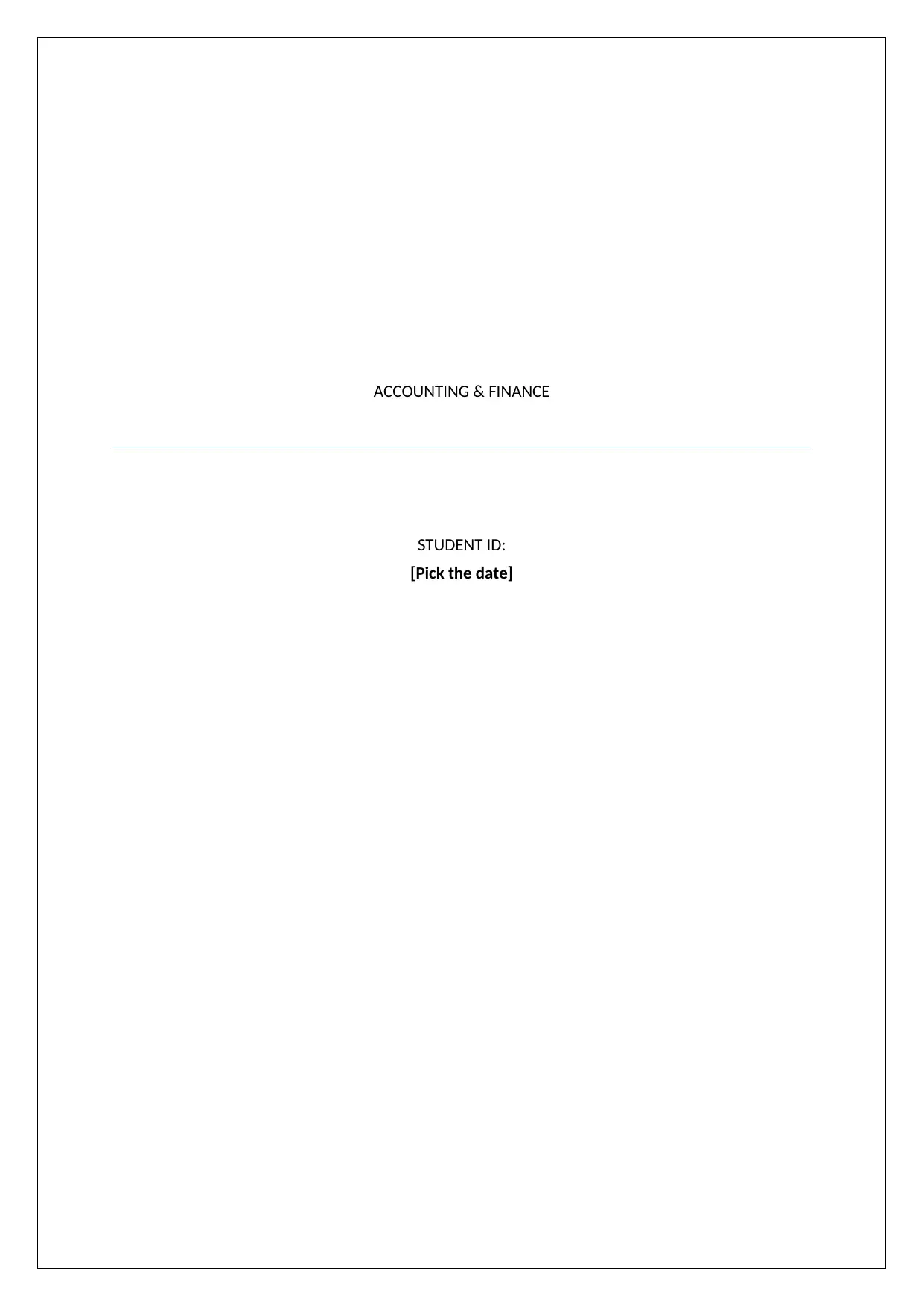
ACCOUNTING & FINANCE
STUDENT ID:
[Pick the date]
STUDENT ID:
[Pick the date]
Secure Best Marks with AI Grader
Need help grading? Try our AI Grader for instant feedback on your assignments.
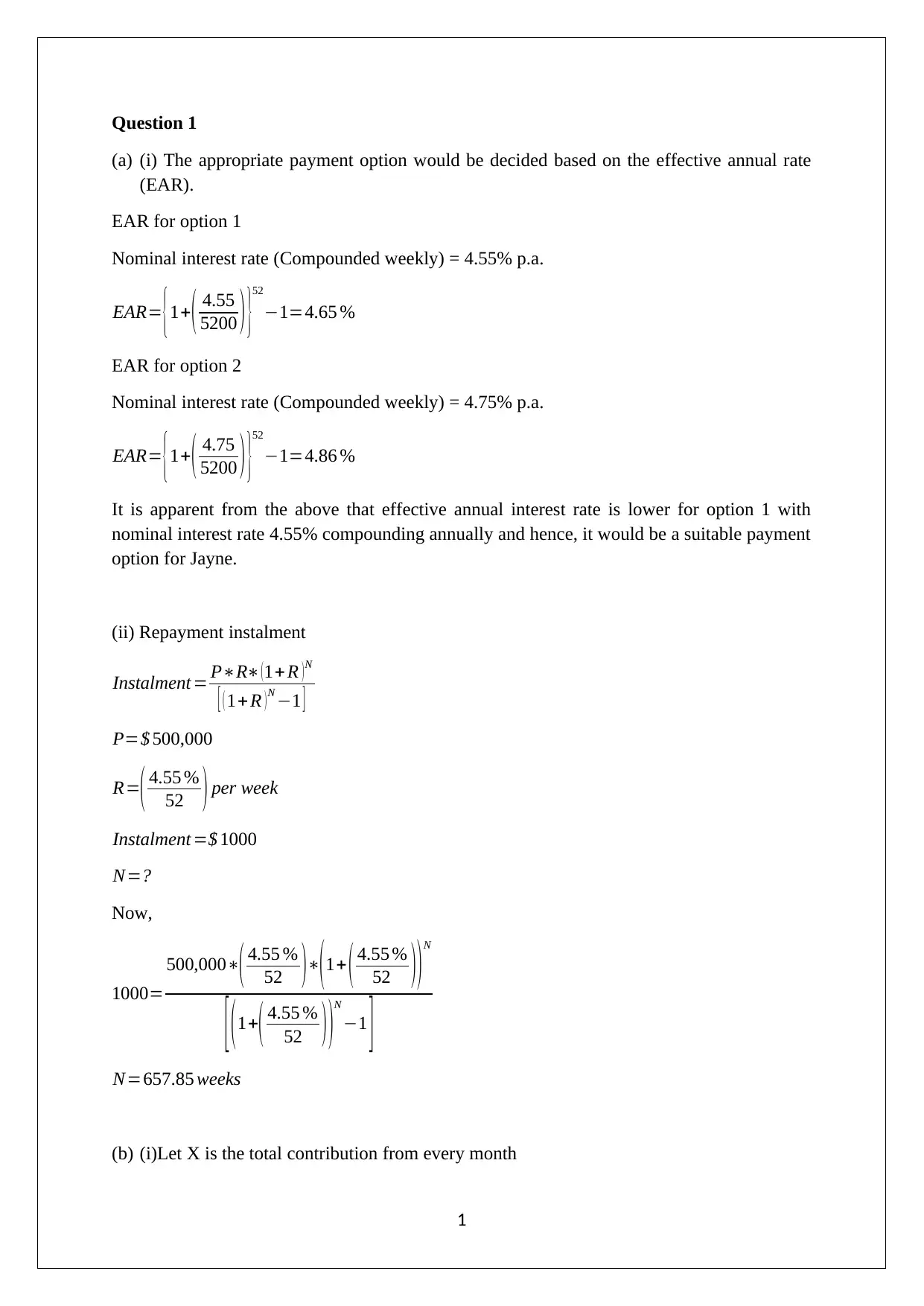
Question 1
(a) (i) The appropriate payment option would be decided based on the effective annual rate
(EAR).
EAR for option 1
Nominal interest rate (Compounded weekly) = 4.55% p.a.
EAR= {1+( 4.55
5200 ) }52
−1=4.65 %
EAR for option 2
Nominal interest rate (Compounded weekly) = 4.75% p.a.
EAR= {1+( 4.75
5200 ) }52
−1=4.86 %
It is apparent from the above that effective annual interest rate is lower for option 1 with
nominal interest rate 4.55% compounding annually and hence, it would be a suitable payment
option for Jayne.
(ii) Repayment instalment
Instalment = P∗R∗ (1+R )N
[ ( 1+ R )N −1 ]
P=$ 500,000
R=( 4.55 %
52 ) per week
Instalment =$ 1000
N=?
Now,
1000=
500,000∗( 4.55 %
52 )∗
( 1+ ( 4.55 %
52 )) N
[ ( 1+( 4.55 %
52 ) )
N
−1 ]
N=657.85 weeks
(b) (i)Let X is the total contribution from every month
1
(a) (i) The appropriate payment option would be decided based on the effective annual rate
(EAR).
EAR for option 1
Nominal interest rate (Compounded weekly) = 4.55% p.a.
EAR= {1+( 4.55
5200 ) }52
−1=4.65 %
EAR for option 2
Nominal interest rate (Compounded weekly) = 4.75% p.a.
EAR= {1+( 4.75
5200 ) }52
−1=4.86 %
It is apparent from the above that effective annual interest rate is lower for option 1 with
nominal interest rate 4.55% compounding annually and hence, it would be a suitable payment
option for Jayne.
(ii) Repayment instalment
Instalment = P∗R∗ (1+R )N
[ ( 1+ R )N −1 ]
P=$ 500,000
R=( 4.55 %
52 ) per week
Instalment =$ 1000
N=?
Now,
1000=
500,000∗( 4.55 %
52 )∗
( 1+ ( 4.55 %
52 )) N
[ ( 1+( 4.55 %
52 ) )
N
−1 ]
N=657.85 weeks
(b) (i)Let X is the total contribution from every month
1
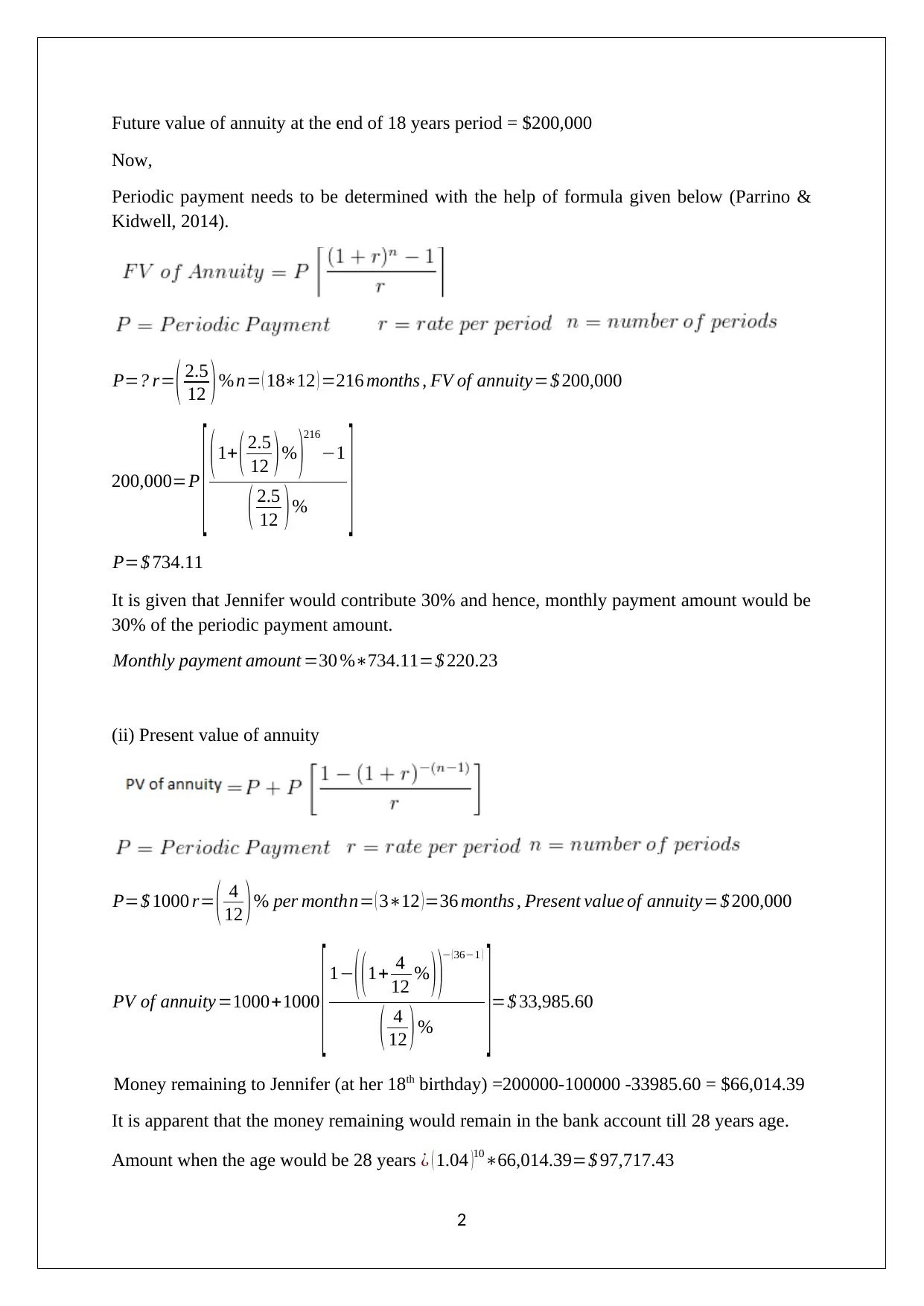
Future value of annuity at the end of 18 years period = $200,000
Now,
Periodic payment needs to be determined with the help of formula given below (Parrino &
Kidwell, 2014).
P=? r= ( 2.5
12 )%n= ( 18∗12 ) =216 months , FV of annuity=$ 200,000
200,000=P
[ ( 1+ ( 2.5
12 ) % )
216
−1
( 2.5
12 ) % ]P=$ 734.11
It is given that Jennifer would contribute 30% and hence, monthly payment amount would be
30% of the periodic payment amount.
Monthly payment amount =30 %∗734.11=$ 220.23
(ii) Present value of annuity
P=$ 1000 r= ( 4
12 )% per monthn= ( 3∗12 )=36 months , Present value of annuity=$ 200,000
PV of annuity=1000+1000
[ 1−
( ( 1+ 4
12 % ) )
− ( 36−1 )
( 4
12 ) % ]=$ 33,985.60
Money remaining to Jennifer (at her 18th birthday) =200000-100000 -33985.60 = $66,014.39
It is apparent that the money remaining would remain in the bank account till 28 years age.
Amount when the age would be 28 years ¿ ( 1.04 )10∗66,014.39=$ 97,717.43
2
Now,
Periodic payment needs to be determined with the help of formula given below (Parrino &
Kidwell, 2014).
P=? r= ( 2.5
12 )%n= ( 18∗12 ) =216 months , FV of annuity=$ 200,000
200,000=P
[ ( 1+ ( 2.5
12 ) % )
216
−1
( 2.5
12 ) % ]P=$ 734.11
It is given that Jennifer would contribute 30% and hence, monthly payment amount would be
30% of the periodic payment amount.
Monthly payment amount =30 %∗734.11=$ 220.23
(ii) Present value of annuity
P=$ 1000 r= ( 4
12 )% per monthn= ( 3∗12 )=36 months , Present value of annuity=$ 200,000
PV of annuity=1000+1000
[ 1−
( ( 1+ 4
12 % ) )
− ( 36−1 )
( 4
12 ) % ]=$ 33,985.60
Money remaining to Jennifer (at her 18th birthday) =200000-100000 -33985.60 = $66,014.39
It is apparent that the money remaining would remain in the bank account till 28 years age.
Amount when the age would be 28 years ¿ ( 1.04 )10∗66,014.39=$ 97,717.43
2

(iii) Loan amount = Cost – Deposit amount
Loan amount=$ 800,000−$ 97,717.43=$ 702,282.57
Monthly Instalment = P∗R∗( 1+ R ) N
[ ( 1+ R ) N −1 ]
P=$ 702,282.57
R=( 4.5
12 )% per month
Instalment =$ 1000
N=30∗12=360 months
Now,
Monthly Repayment Instalment =
702,282.57∗( 4.5 %
12 )∗
( 1+ ( 4.5 %
12 ) )
360
[ ( 1+( 4.5 %
12 ))
360
−1 ]
Monthly Repayment Instalment=$ 3,558.27
Question 2
The relevant screenshot for excel computation of the cash flows from ordinary equity coupled
with market value of the various financing instruments is shown below.
3
Loan amount=$ 800,000−$ 97,717.43=$ 702,282.57
Monthly Instalment = P∗R∗( 1+ R ) N
[ ( 1+ R ) N −1 ]
P=$ 702,282.57
R=( 4.5
12 )% per month
Instalment =$ 1000
N=30∗12=360 months
Now,
Monthly Repayment Instalment =
702,282.57∗( 4.5 %
12 )∗
( 1+ ( 4.5 %
12 ) )
360
[ ( 1+( 4.5 %
12 ))
360
−1 ]
Monthly Repayment Instalment=$ 3,558.27
Question 2
The relevant screenshot for excel computation of the cash flows from ordinary equity coupled
with market value of the various financing instruments is shown below.
3
Secure Best Marks with AI Grader
Need help grading? Try our AI Grader for instant feedback on your assignments.
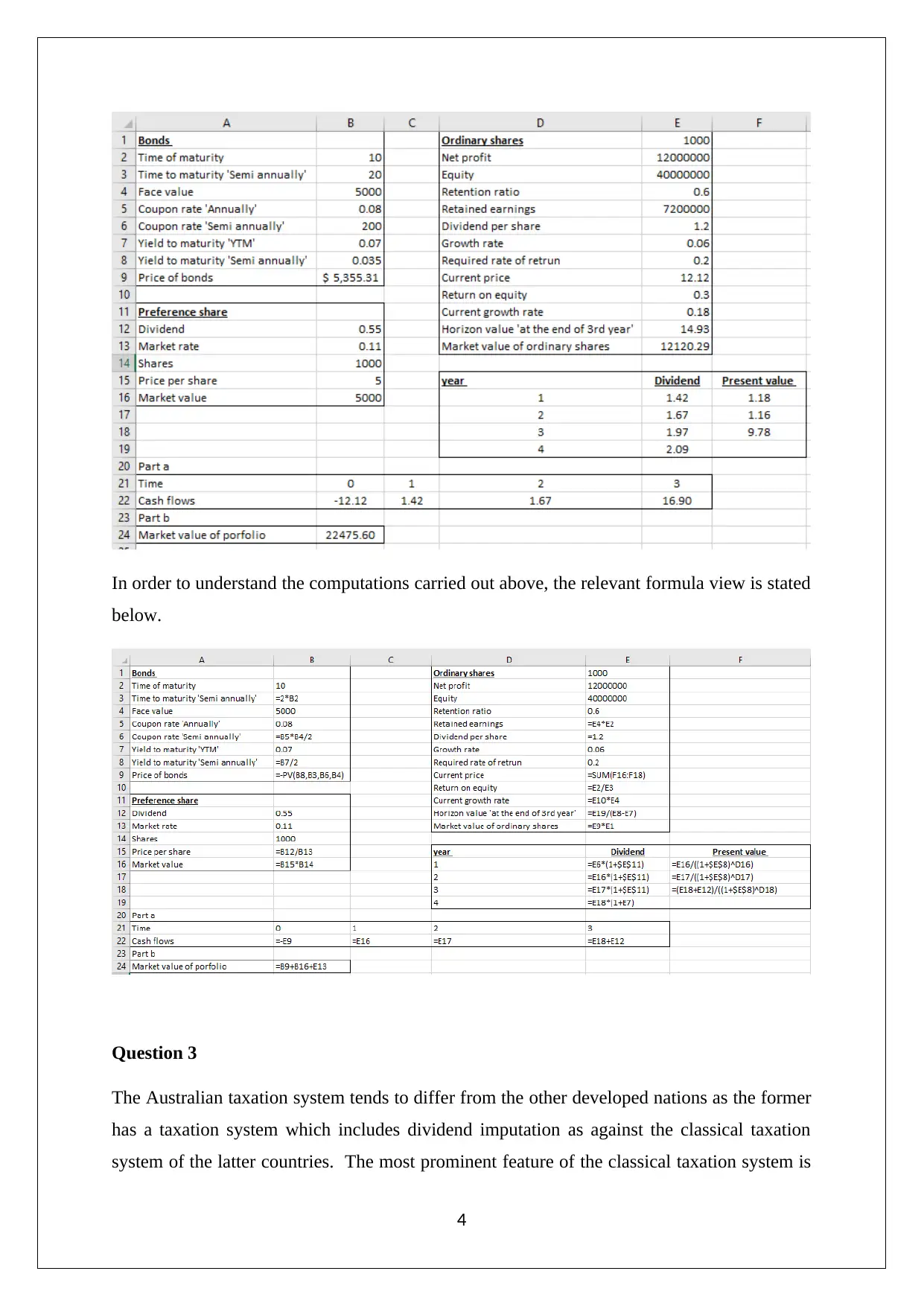
In order to understand the computations carried out above, the relevant formula view is stated
below.
Question 3
The Australian taxation system tends to differ from the other developed nations as the former
has a taxation system which includes dividend imputation as against the classical taxation
system of the latter countries. The most prominent feature of the classical taxation system is
4
below.
Question 3
The Australian taxation system tends to differ from the other developed nations as the former
has a taxation system which includes dividend imputation as against the classical taxation
system of the latter countries. The most prominent feature of the classical taxation system is
4
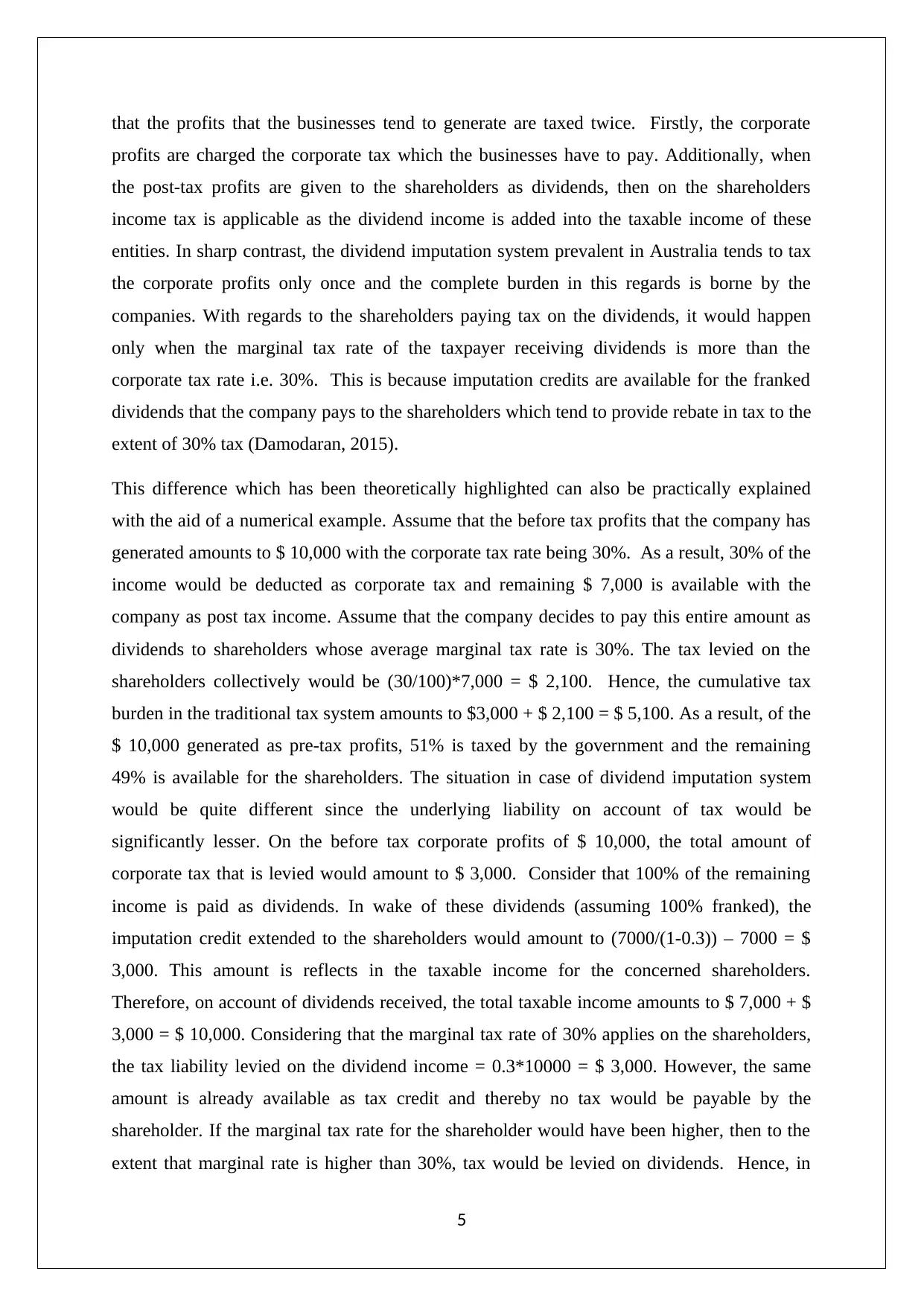
that the profits that the businesses tend to generate are taxed twice. Firstly, the corporate
profits are charged the corporate tax which the businesses have to pay. Additionally, when
the post-tax profits are given to the shareholders as dividends, then on the shareholders
income tax is applicable as the dividend income is added into the taxable income of these
entities. In sharp contrast, the dividend imputation system prevalent in Australia tends to tax
the corporate profits only once and the complete burden in this regards is borne by the
companies. With regards to the shareholders paying tax on the dividends, it would happen
only when the marginal tax rate of the taxpayer receiving dividends is more than the
corporate tax rate i.e. 30%. This is because imputation credits are available for the franked
dividends that the company pays to the shareholders which tend to provide rebate in tax to the
extent of 30% tax (Damodaran, 2015).
This difference which has been theoretically highlighted can also be practically explained
with the aid of a numerical example. Assume that the before tax profits that the company has
generated amounts to $ 10,000 with the corporate tax rate being 30%. As a result, 30% of the
income would be deducted as corporate tax and remaining $ 7,000 is available with the
company as post tax income. Assume that the company decides to pay this entire amount as
dividends to shareholders whose average marginal tax rate is 30%. The tax levied on the
shareholders collectively would be (30/100)*7,000 = $ 2,100. Hence, the cumulative tax
burden in the traditional tax system amounts to $3,000 + $ 2,100 = $ 5,100. As a result, of the
$ 10,000 generated as pre-tax profits, 51% is taxed by the government and the remaining
49% is available for the shareholders. The situation in case of dividend imputation system
would be quite different since the underlying liability on account of tax would be
significantly lesser. On the before tax corporate profits of $ 10,000, the total amount of
corporate tax that is levied would amount to $ 3,000. Consider that 100% of the remaining
income is paid as dividends. In wake of these dividends (assuming 100% franked), the
imputation credit extended to the shareholders would amount to (7000/(1-0.3)) – 7000 = $
3,000. This amount is reflects in the taxable income for the concerned shareholders.
Therefore, on account of dividends received, the total taxable income amounts to $ 7,000 + $
3,000 = $ 10,000. Considering that the marginal tax rate of 30% applies on the shareholders,
the tax liability levied on the dividend income = 0.3*10000 = $ 3,000. However, the same
amount is already available as tax credit and thereby no tax would be payable by the
shareholder. If the marginal tax rate for the shareholder would have been higher, then to the
extent that marginal rate is higher than 30%, tax would be levied on dividends. Hence, in
5
profits are charged the corporate tax which the businesses have to pay. Additionally, when
the post-tax profits are given to the shareholders as dividends, then on the shareholders
income tax is applicable as the dividend income is added into the taxable income of these
entities. In sharp contrast, the dividend imputation system prevalent in Australia tends to tax
the corporate profits only once and the complete burden in this regards is borne by the
companies. With regards to the shareholders paying tax on the dividends, it would happen
only when the marginal tax rate of the taxpayer receiving dividends is more than the
corporate tax rate i.e. 30%. This is because imputation credits are available for the franked
dividends that the company pays to the shareholders which tend to provide rebate in tax to the
extent of 30% tax (Damodaran, 2015).
This difference which has been theoretically highlighted can also be practically explained
with the aid of a numerical example. Assume that the before tax profits that the company has
generated amounts to $ 10,000 with the corporate tax rate being 30%. As a result, 30% of the
income would be deducted as corporate tax and remaining $ 7,000 is available with the
company as post tax income. Assume that the company decides to pay this entire amount as
dividends to shareholders whose average marginal tax rate is 30%. The tax levied on the
shareholders collectively would be (30/100)*7,000 = $ 2,100. Hence, the cumulative tax
burden in the traditional tax system amounts to $3,000 + $ 2,100 = $ 5,100. As a result, of the
$ 10,000 generated as pre-tax profits, 51% is taxed by the government and the remaining
49% is available for the shareholders. The situation in case of dividend imputation system
would be quite different since the underlying liability on account of tax would be
significantly lesser. On the before tax corporate profits of $ 10,000, the total amount of
corporate tax that is levied would amount to $ 3,000. Consider that 100% of the remaining
income is paid as dividends. In wake of these dividends (assuming 100% franked), the
imputation credit extended to the shareholders would amount to (7000/(1-0.3)) – 7000 = $
3,000. This amount is reflects in the taxable income for the concerned shareholders.
Therefore, on account of dividends received, the total taxable income amounts to $ 7,000 + $
3,000 = $ 10,000. Considering that the marginal tax rate of 30% applies on the shareholders,
the tax liability levied on the dividend income = 0.3*10000 = $ 3,000. However, the same
amount is already available as tax credit and thereby no tax would be payable by the
shareholder. If the marginal tax rate for the shareholder would have been higher, then to the
extent that marginal rate is higher than 30%, tax would be levied on dividends. Hence, in
5
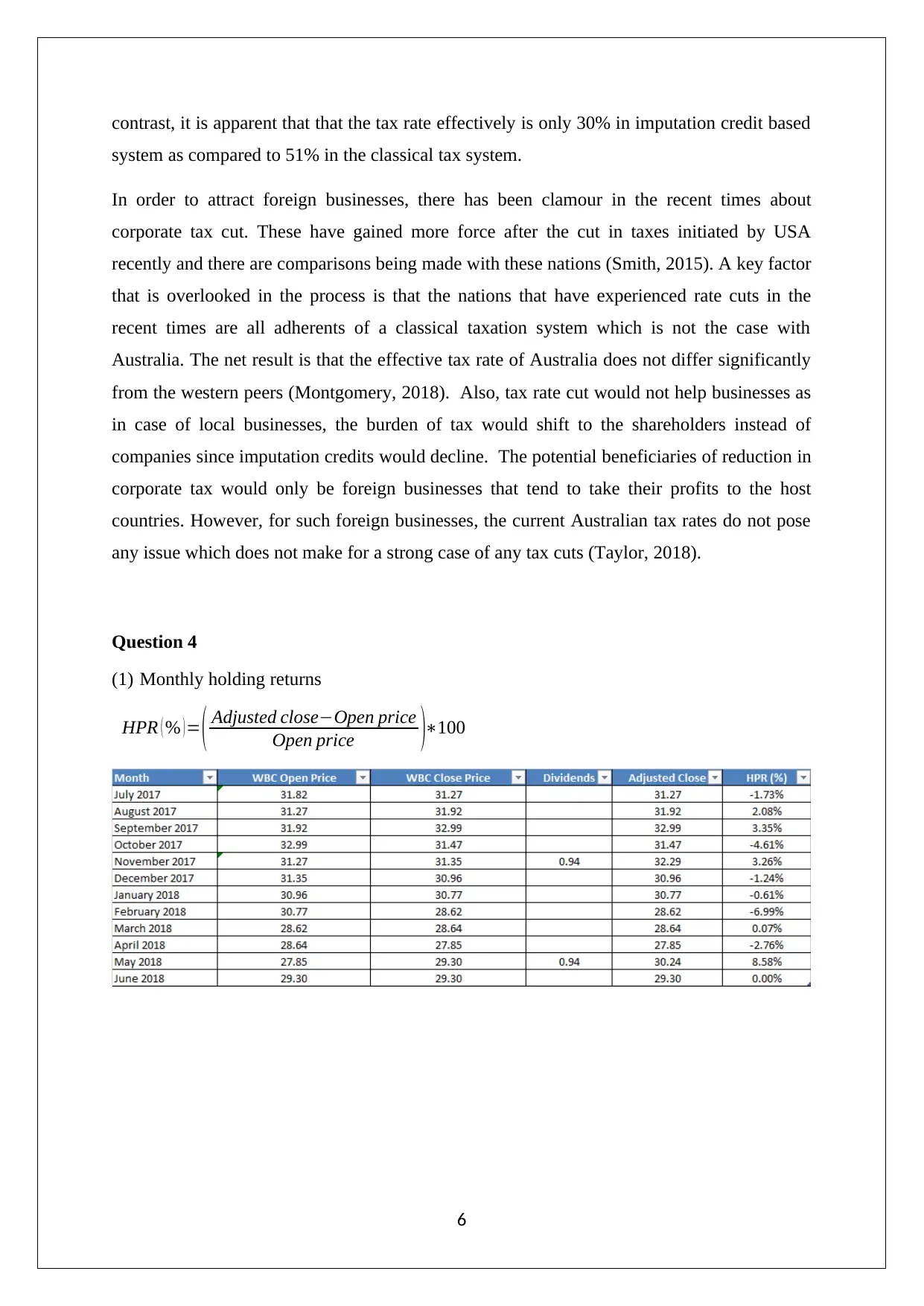
contrast, it is apparent that that the tax rate effectively is only 30% in imputation credit based
system as compared to 51% in the classical tax system.
In order to attract foreign businesses, there has been clamour in the recent times about
corporate tax cut. These have gained more force after the cut in taxes initiated by USA
recently and there are comparisons being made with these nations (Smith, 2015). A key factor
that is overlooked in the process is that the nations that have experienced rate cuts in the
recent times are all adherents of a classical taxation system which is not the case with
Australia. The net result is that the effective tax rate of Australia does not differ significantly
from the western peers (Montgomery, 2018). Also, tax rate cut would not help businesses as
in case of local businesses, the burden of tax would shift to the shareholders instead of
companies since imputation credits would decline. The potential beneficiaries of reduction in
corporate tax would only be foreign businesses that tend to take their profits to the host
countries. However, for such foreign businesses, the current Australian tax rates do not pose
any issue which does not make for a strong case of any tax cuts (Taylor, 2018).
Question 4
(1) Monthly holding returns
HPR ( % ) = ( Adjusted close−Open price
Open price )∗100
6
system as compared to 51% in the classical tax system.
In order to attract foreign businesses, there has been clamour in the recent times about
corporate tax cut. These have gained more force after the cut in taxes initiated by USA
recently and there are comparisons being made with these nations (Smith, 2015). A key factor
that is overlooked in the process is that the nations that have experienced rate cuts in the
recent times are all adherents of a classical taxation system which is not the case with
Australia. The net result is that the effective tax rate of Australia does not differ significantly
from the western peers (Montgomery, 2018). Also, tax rate cut would not help businesses as
in case of local businesses, the burden of tax would shift to the shareholders instead of
companies since imputation credits would decline. The potential beneficiaries of reduction in
corporate tax would only be foreign businesses that tend to take their profits to the host
countries. However, for such foreign businesses, the current Australian tax rates do not pose
any issue which does not make for a strong case of any tax cuts (Taylor, 2018).
Question 4
(1) Monthly holding returns
HPR ( % ) = ( Adjusted close−Open price
Open price )∗100
6
Paraphrase This Document
Need a fresh take? Get an instant paraphrase of this document with our AI Paraphraser
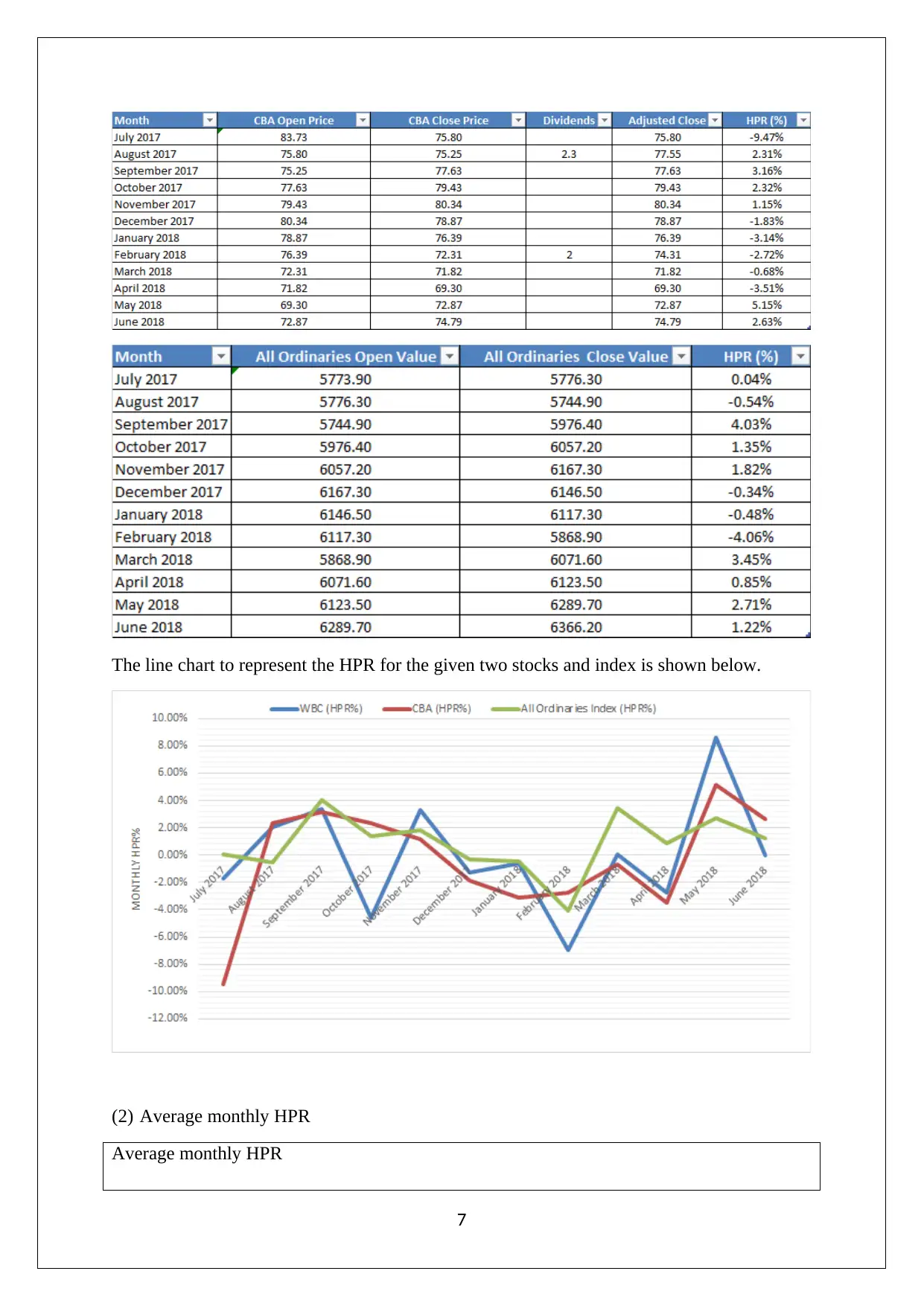
The line chart to represent the HPR for the given two stocks and index is shown below.
(2) Average monthly HPR
Average monthly HPR
7
(2) Average monthly HPR
Average monthly HPR
7
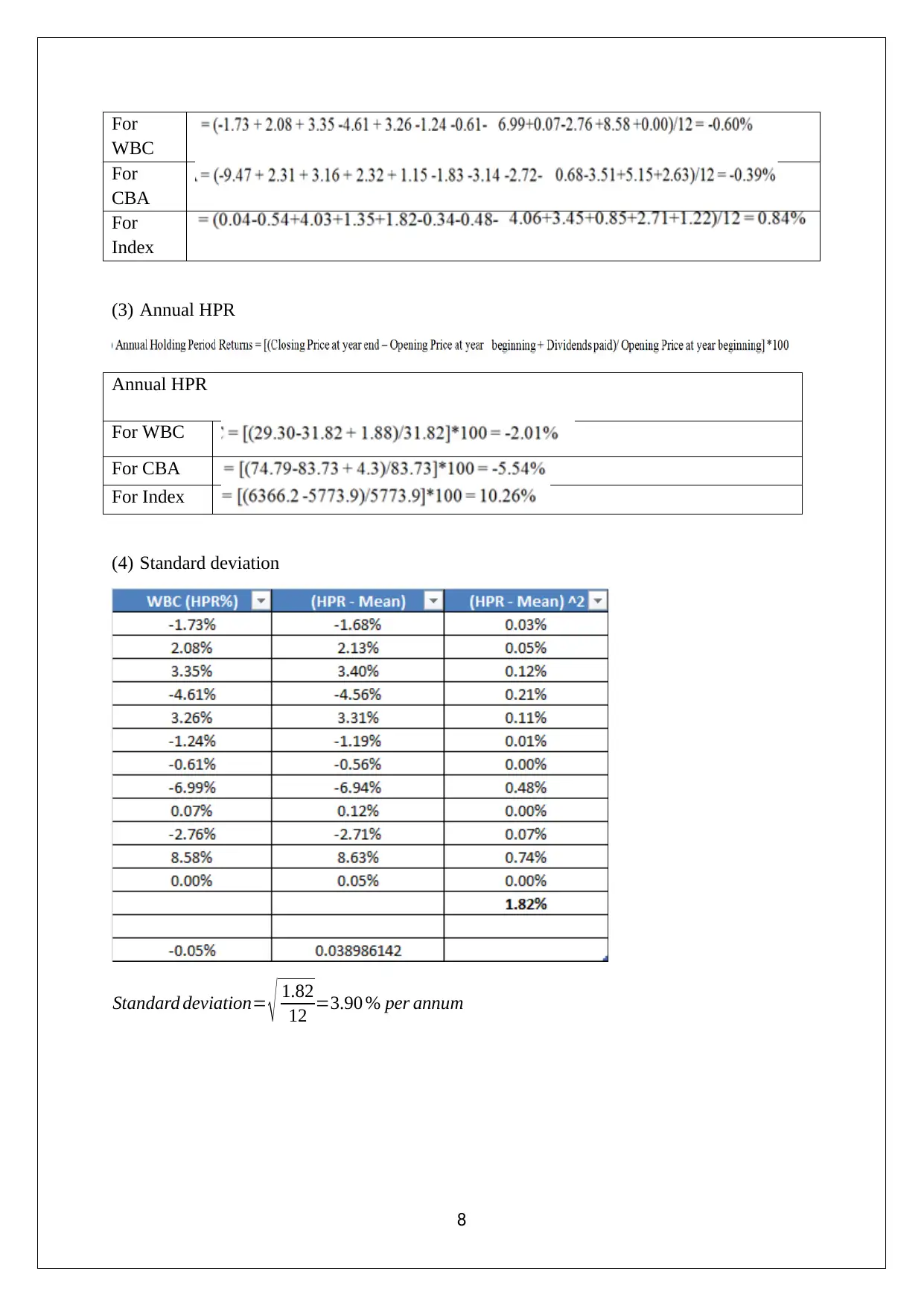
For
WBC
For
CBA
For
Index
(3) Annual HPR
Annual HPR
For WBC
For CBA
For Index
(4) Standard deviation
Standard deviation= √ 1.82
12 =3.90 % per annum
8
WBC
For
CBA
For
Index
(3) Annual HPR
Annual HPR
For WBC
For CBA
For Index
(4) Standard deviation
Standard deviation= √ 1.82
12 =3.90 % per annum
8
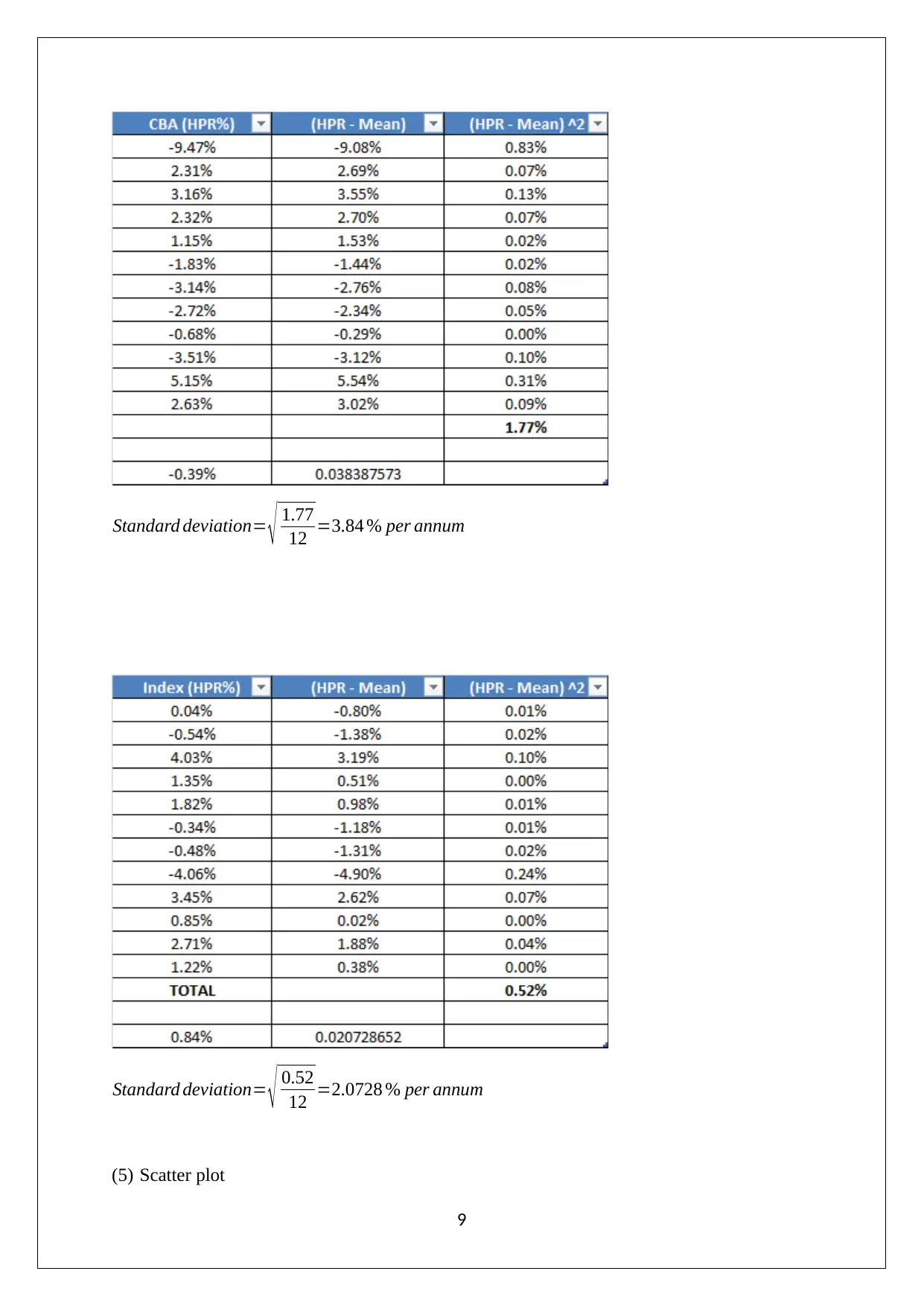
Standard deviation= √ 1.77
12 =3.84 % per annum
Standard deviation= √ 0.52
12 =2.0728 % per annum
(5) Scatter plot
9
12 =3.84 % per annum
Standard deviation= √ 0.52
12 =2.0728 % per annum
(5) Scatter plot
9
Secure Best Marks with AI Grader
Need help grading? Try our AI Grader for instant feedback on your assignments.
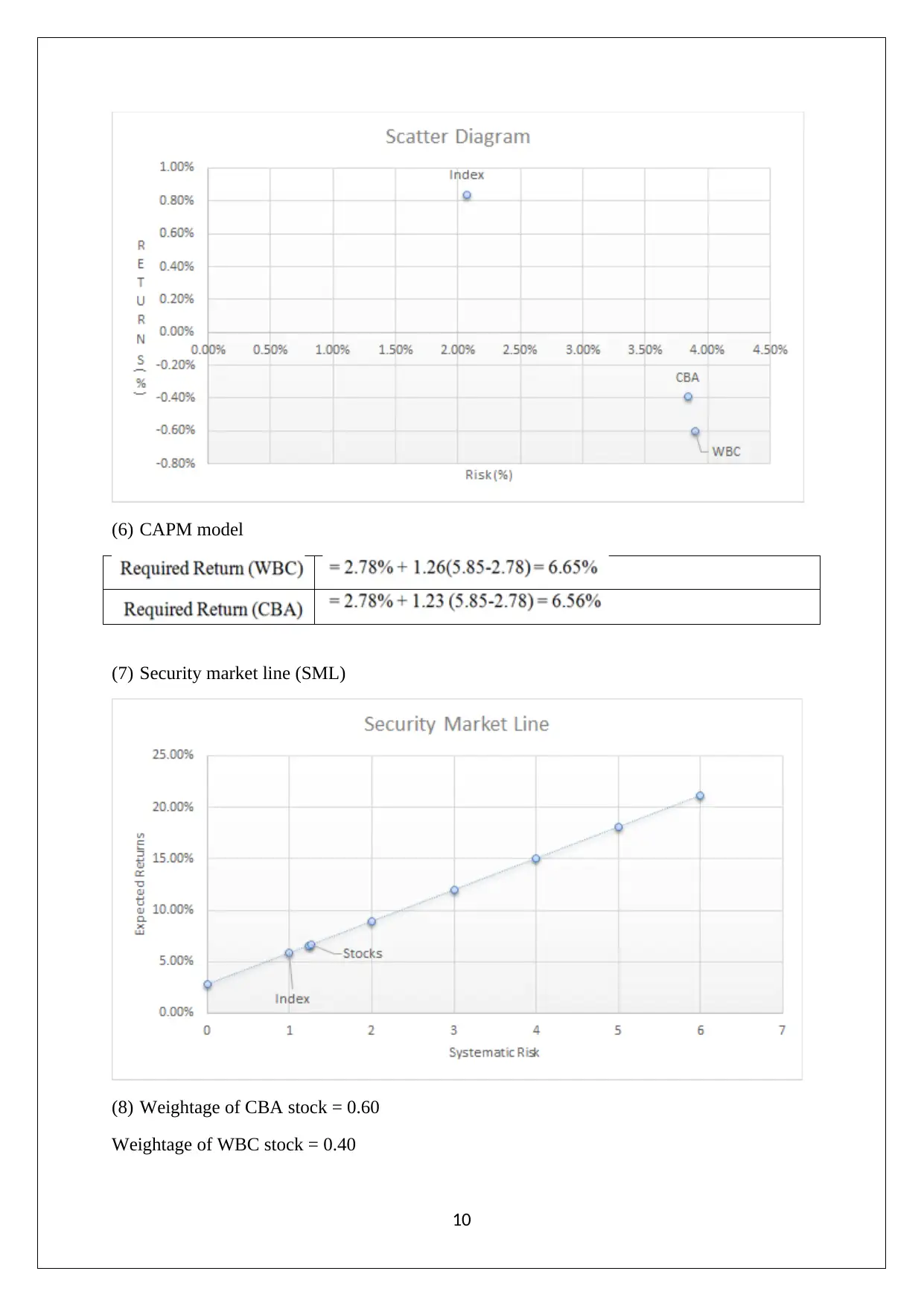
(6) CAPM model
(7) Security market line (SML)
(8) Weightage of CBA stock = 0.60
Weightage of WBC stock = 0.40
10
(7) Security market line (SML)
(8) Weightage of CBA stock = 0.60
Weightage of WBC stock = 0.40
10
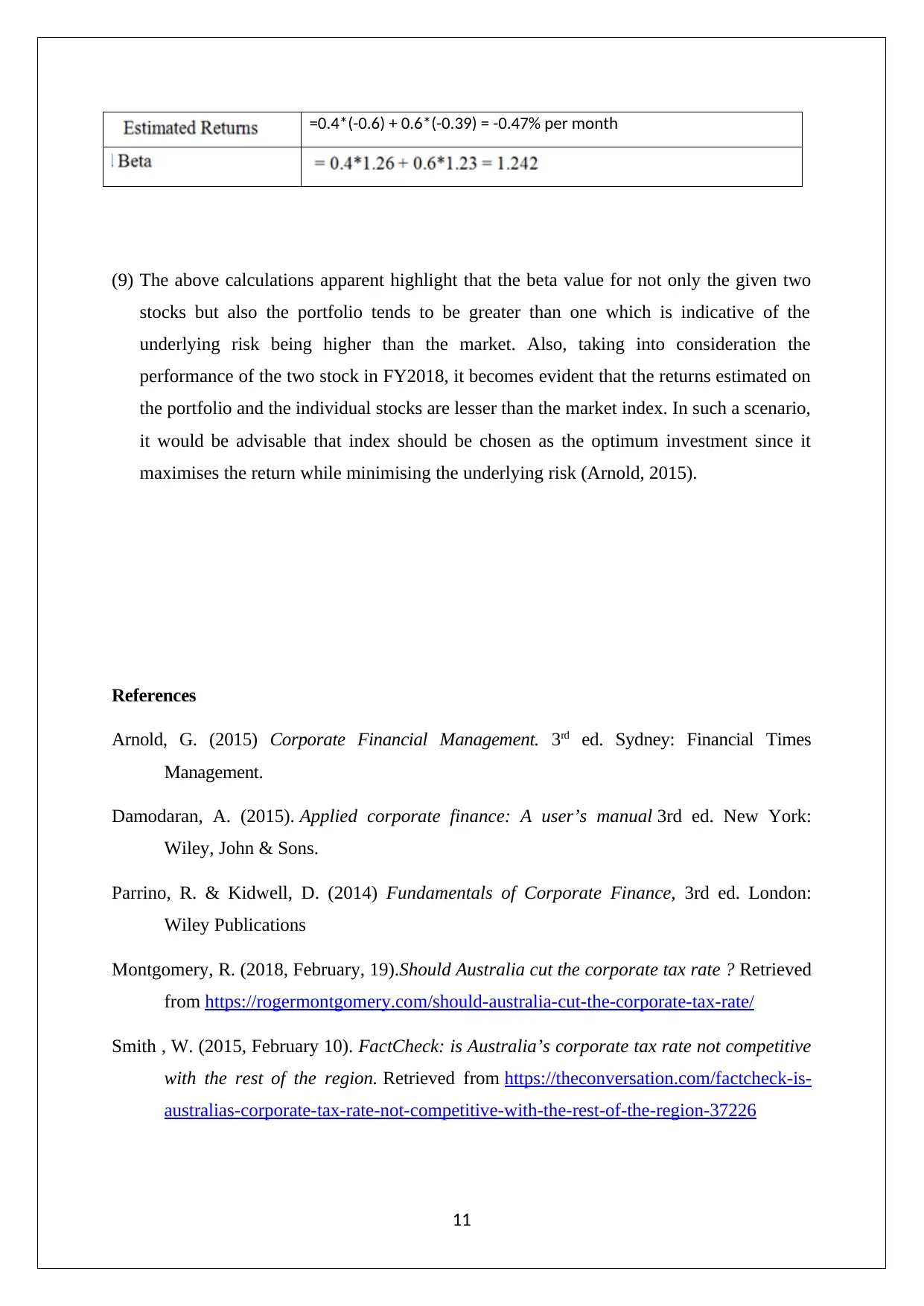
=0.4*(-0.6) + 0.6*(-0.39) = -0.47% per month
(9) The above calculations apparent highlight that the beta value for not only the given two
stocks but also the portfolio tends to be greater than one which is indicative of the
underlying risk being higher than the market. Also, taking into consideration the
performance of the two stock in FY2018, it becomes evident that the returns estimated on
the portfolio and the individual stocks are lesser than the market index. In such a scenario,
it would be advisable that index should be chosen as the optimum investment since it
maximises the return while minimising the underlying risk (Arnold, 2015).
References
Arnold, G. (2015) Corporate Financial Management. 3rd ed. Sydney: Financial Times
Management.
Damodaran, A. (2015). Applied corporate finance: A user’s manual 3rd ed. New York:
Wiley, John & Sons.
Parrino, R. & Kidwell, D. (2014) Fundamentals of Corporate Finance, 3rd ed. London:
Wiley Publications
Montgomery, R. (2018, February, 19).Should Australia cut the corporate tax rate ? Retrieved
from https://rogermontgomery.com/should-australia-cut-the-corporate-tax-rate/
Smith , W. (2015, February 10). FactCheck: is Australia’s corporate tax rate not competitive
with the rest of the region. Retrieved from https://theconversation.com/factcheck-is-
australias-corporate-tax-rate-not-competitive-with-the-rest-of-the-region-37226
11
(9) The above calculations apparent highlight that the beta value for not only the given two
stocks but also the portfolio tends to be greater than one which is indicative of the
underlying risk being higher than the market. Also, taking into consideration the
performance of the two stock in FY2018, it becomes evident that the returns estimated on
the portfolio and the individual stocks are lesser than the market index. In such a scenario,
it would be advisable that index should be chosen as the optimum investment since it
maximises the return while minimising the underlying risk (Arnold, 2015).
References
Arnold, G. (2015) Corporate Financial Management. 3rd ed. Sydney: Financial Times
Management.
Damodaran, A. (2015). Applied corporate finance: A user’s manual 3rd ed. New York:
Wiley, John & Sons.
Parrino, R. & Kidwell, D. (2014) Fundamentals of Corporate Finance, 3rd ed. London:
Wiley Publications
Montgomery, R. (2018, February, 19).Should Australia cut the corporate tax rate ? Retrieved
from https://rogermontgomery.com/should-australia-cut-the-corporate-tax-rate/
Smith , W. (2015, February 10). FactCheck: is Australia’s corporate tax rate not competitive
with the rest of the region. Retrieved from https://theconversation.com/factcheck-is-
australias-corporate-tax-rate-not-competitive-with-the-rest-of-the-region-37226
11
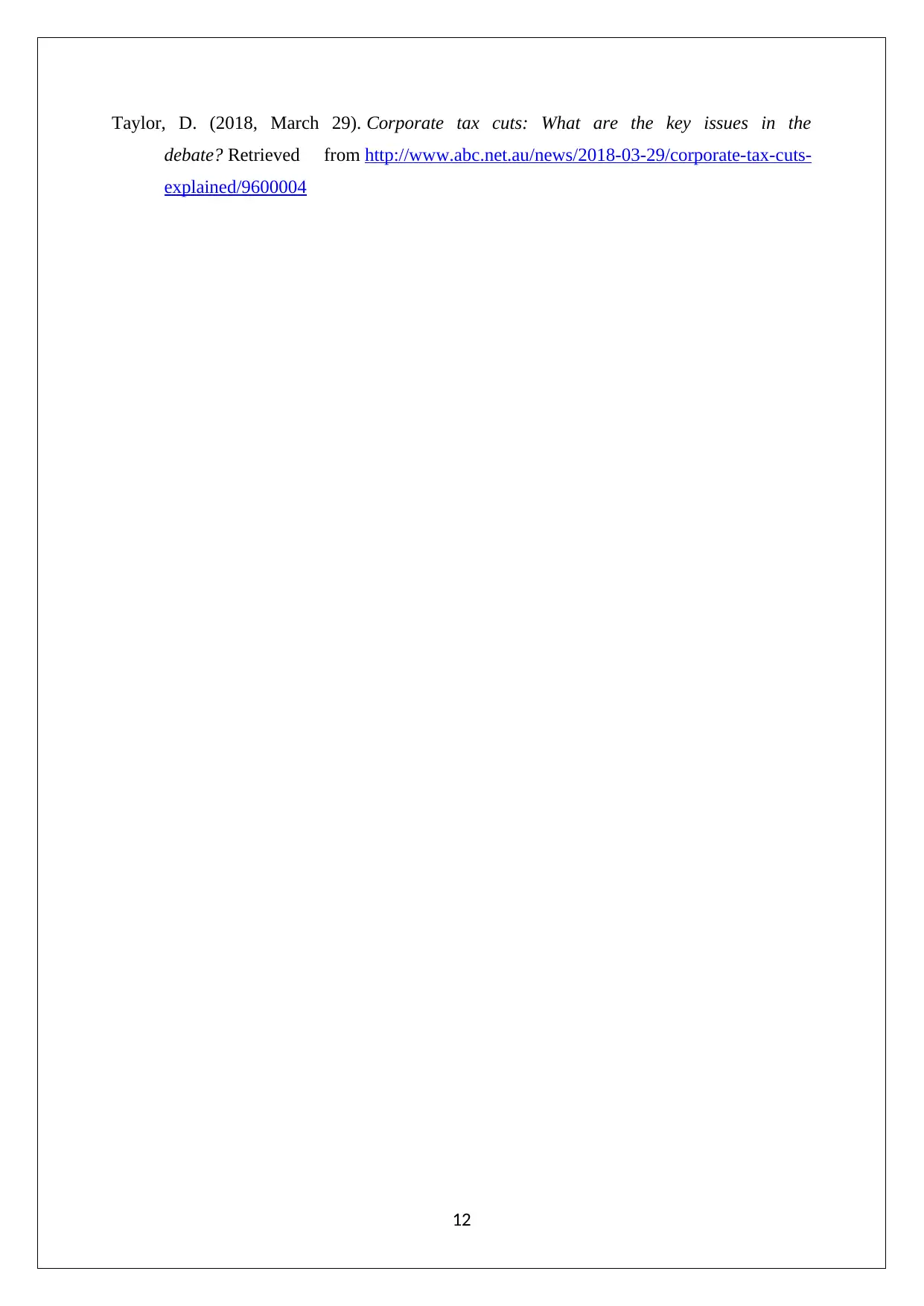
Taylor, D. (2018, March 29). Corporate tax cuts: What are the key issues in the
debate? Retrieved from http://www.abc.net.au/news/2018-03-29/corporate-tax-cuts-
explained/9600004
12
debate? Retrieved from http://www.abc.net.au/news/2018-03-29/corporate-tax-cuts-
explained/9600004
12
1 out of 13
Related Documents
Your All-in-One AI-Powered Toolkit for Academic Success.
+13062052269
info@desklib.com
Available 24*7 on WhatsApp / Email
![[object Object]](/_next/static/media/star-bottom.7253800d.svg)
Unlock your academic potential
© 2024 | Zucol Services PVT LTD | All rights reserved.



